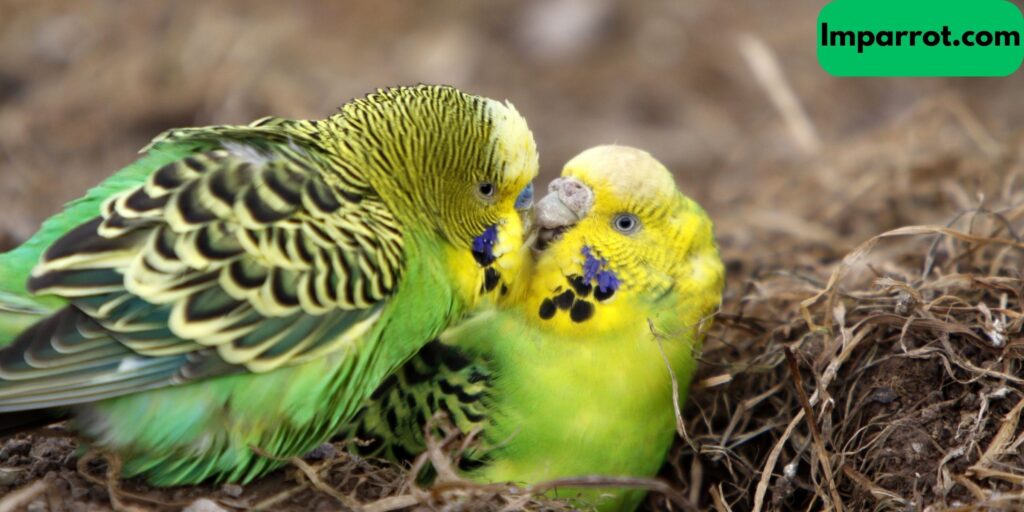Do Budgies Need to be in Pairs? (Expert Opinion)
Last Updated on March 16, 2024 by Ali Shahid
Having a pet budgie isn’t just about enjoying their pleasant company; it’s also about recognizing their need for social interaction. Budgies are social animals that thrive on being around others. A common question that often comes up for those thinking about or already owning a budgie is: Do budgies need a companion? Generally, having two budgies is better than having just one. Budgies like to be part of a group, and in the wild, they live in big flocks. Two budgies, along with a couple of mirrors, can mimic the contact and noise of a flock, even though it’s a small one.
A lone budgie misses out on interacting with other budgies, leading to potential behavior issues unless you spend quality time with your feathered friends. This question highlights the importance of understanding the social needs of budgies to ensure their emotional well-being and overall health. In this article, we’ll explore the pros and cons of having budgies in pairs and provide insights into introducing new budgies to each other.

Understanding Budgie’s Social Behavior
Budgerigars, commonly called budgies, hail from the open spaces of Australia, dwelling in scrublands, open woodlands, and grasslands. These birds are highly social and tend to form small flocks, sometimes expanding to thousands after rainfall and the availability of food.
Within these flocks, they establish intricate social connections, expressing affection and communication to guide the group toward new resources. Their social structure involves creating close-knit groups that offer safety, companionship, and a support system for survival.
The well-being of budgies is heavily influenced by social interactions. In the wild, being solitary is perilous, as it implies a lack of protection and resources. Similarly, in captivity, loneliness can lead to issues like a loss of appetite, feather plucking, and signs of stress. Budgies thrive on interaction, and their emotional health is intricately linked to their social surroundings.
The behavior of budgies differs significantly when they are alone versus when they are in pairs or groups. A lone budgie may experience loneliness, displaying stress or boredom, whereas budgies in pairs or groups engage in natural social behaviors like preening, chirping, and playing together.
These interactions not only provide mental stimulation but also reduce stress, contributing to overall mental and emotional well-being. Budgies kept alone may not fully develop their social skills, potentially leading to behavioral problems. On the flip side, budgies in pairs or groups can learn from each other’s communication styles, developing a shared language that enhances their overall communication skills and fosters a sense of belonging and understanding.
The Benefits of Pairing Budgies
Pairing budgies brings about significant improvements in both their emotional and physical well-being. In their natural habitat, budgies are social creatures that thrive in flocks, and this social need persists even in captivity. Having a fellow budgie creates a sense of security and belonging, vital for their emotional health. The physical advantages are just as important; paired budgies partake in active play and flight, ensuring they stay physically fit and maintain vibrant plumage.
For these intelligent creatures, mental stimulation is key to their health and happiness. A companion offers constant entertainment and opportunities for playful activities, preventing boredom. Mimicking each other’s sounds and engaging in lively conversations contribute to a harmonious and joyful atmosphere, promoting their mental well-being.
Companionship plays a crucial role in warding off loneliness and stress in budgies. Without a partner, budgies may experience loneliness, leading to stress-related behaviors like feather plucking or loss of appetite. Pairing budgies enables them to partake in natural social behaviors such as preening, chirping, and playing together, reducing stress and fostering overall mental and emotional health.
Mutual grooming is a bonding activity frequently observed in paired budgies. This behavior not only signifies affection but also helps in keeping their feathers clean and well-maintained. Bonded budgies may also engage in synchronized flights or playful chases, strengthening their bond and providing both physical exercise and mental enrichment.
Potential Challenges with Budgie Pairing
Pairing budgies can come with various challenges, such as dealing with aggression, compatibility issues, understanding gender dynamics, and managing breeding behavior to prevent unwanted offspring.
Aggression and compatibility can arise due to hormones, jealousy, or the mating season. Breeding season, in particular, can lead to territorial and protective behaviors, especially among male budgies.
Moodiness or aggression may also occur when budgies are in breeding condition. If one bird consistently distresses another, separating them may be necessary to prevent injuries. Persistent fighting between two budgies requires identifying the cause and separating them if needed.
Understanding the gender dynamics of budgies is crucial for establishing suitable social interactions. Typically, male budgies are more social and friendly, while females tend to be more aggressive. Male-male pairs generally get along well, whereas female-female pairs may face territorial disputes.
Male-female pairs can coexist peacefully, but their thoughts may turn to mating, potentially leading to unwanted offspring if not managed properly. Managing breeding behavior can be challenging for beginners. Some pairs may refuse to mate, and problems can arise during the breeding process.
To avoid adding budgie chicks to your aviary, ensure there are no potential nesting holes in the cage. If unwanted eggs are laid, options include using dummy eggs to stop laying or manipulating the eggs through shaking, boiling, or freezing before returning them to the cage.
How to Introduce Budgies to Each Other?
Introducing budgies to each other involves a careful process, including quarantine, gradual introduction, and attentive observation of their interactions.
Before bringing a new budgie to your existing one, it’s essential to quarantine the newcomer for approximately a month. This precautionary measure helps prevent the spread of potentially contagious diseases like chlamydia, salmonella, polyomavirus, or psittacine beak and feather disease. During quarantine, keep the new bird in a separate cage in a different room. A visit to an avian veterinarian is advisable to screen for any possible diseases.
Here’s a step-by-step guide for a safe introduction:
- Gradual Introduction: After the quarantine period, position the two cages in the same room but at a distance. This allows the birds to become accustomed to each other’s sight and sound. Gradually bring the cages closer over several days or weeks.
- First Interaction: With strict supervision, introduce the two birds. Monitor them closely for any signs of bullying or aggression.
- Creating a Safe Environment: Ensure the introduction space has ample toys and branches for play and perching, allowing the birds to feel secure.
- Observation: Watch the birds closely during their interactions. If they engage in a fight, intervene promptly and separate them.
Recognizing positive and negative signs is crucial:
- Positive Signs: Birds sitting together, singing, and preening each other.
- Negative Signs: Flapping, squawking, flying to opposite corners, pecking, and signs of aggression.
It’s important to note that some birds may not accept new members into their territory, and some may only tolerate each other without becoming friends. If issues arise, consulting with a veterinarian is recommended.

Housing and Environment for Budgie Pairs
When setting up a cage for a pair of budgies, it’s crucial to prioritize their active lifestyle and provide ample space. The minimum recommended cage size for two budgies is 30 inches in length, 18 inches in width, and 18 inches in height. Larger cages are preferable, allowing more room for flying, a vital exercise for these birds. Ensure the cage has horizontal bars for climbing, with multiple perches of different textures and diameters to support foot health. Maintain bar spacing at no more than 1/2 inch to prevent escape or injury.
Environmental enrichment is key for the mental and physical well-being of budgies. Offer a variety of toys, swings, and foraging opportunities to keep them engaged and ward off boredom. Establish separate feeding stations to minimize food competition and reduce aggression. Each budgie should have its own space within the cage for privacy.
To maintain a harmonious environment:
- Gradual Introduction: Introduce new birds gradually in neutral territory to minimize territorial aggression.
- Close Monitoring: Watch their interactions closely and be ready to separate them if conflicts arise.
- Rotation of Toys: Regularly rotate toys and change the cage layout to keep the environment stimulating and fresh.
- Ideal Cage Placement: Place the cage in a location with natural light, avoiding direct sunlight and drafts.
- Consistent Routine: Provide a consistent routine and quiet time for the birds to rest.
By adhering to these guidelines, you can create a secure and enjoyable living space for your budgie pair, enhancing their well-being and reinforcing their bond.
Interaction with Paired Budgies and Human Bonding
Maintaining a balanced approach to attention between paired budgies and human interaction is crucial for their overall well-being. While budgie companionship is valuable, they still need individual attention from their human caretakers for socialization and enrichment.
Spending time with each budgie individually is recommended to strengthen your bond with them and ensure they are comfortable with human interaction. Taking each bird out of the cage separately for one-on-one time is a practical way to achieve this balance.
Training and taming paired budgies can present challenges as they may be more focused on each other than on the caretaker. However, positive reinforcement techniques and consistent, short training sessions can be effective. Begin by acclimating them to your presence and gradually introduce training exercises. Initially, work with each bird individually to establish a personal connection.
Encouraging speech and play in paired budgies can be done without disrupting their bond by incorporating interactive activities involving both birds and their human caretaker. Regularly speaking to them, using repetition, and providing positive reinforcement can aid in teaching new words and phrases.
Including both birds in playtime with various toys stimulates their minds and encourages vocalization and interaction. This approach prevents jealousy and maintains a harmonious relationship between them.
By carefully balancing individual attention, employing strategic training methods, and fostering an environment that encourages speech and play, you can successfully bond with each budgie while respecting and nurturing their bond with each other.
Conclusion
Budgies, being highly social creatures, thrive on companionship, reflecting their natural behavior in the wild where they live in flocks. The decision to keep budgies in pairs requires careful consideration of their social needs, along with potential challenges and responsibilities.
Pairing budgies can bring about benefits like improved emotional and physical health, mental stimulation, and reduced loneliness and stress. However, it’s essential to be aware of challenges such as aggression, compatibility issues, and the need to manage breeding behavior.
As a responsible budgie owner, providing a suitable environment is crucial, including a spacious cage, environmental enrichment, and a balance of attention between the budgie pair and human interaction. Training and taming considerations also play a role, as does encouraging speech and play without disrupting their bond.
Ultimately, the decision to keep budgies in pairs should stem from a commitment to meeting their social needs and creating a nurturing environment. Responsible pet ownership involves understanding and respecting the natural behaviors and needs of your pets. Additional research and consultation with avian experts or veterinarians can provide valuable insights and guidance on the best care for budgies, whether individually or in pairs.

